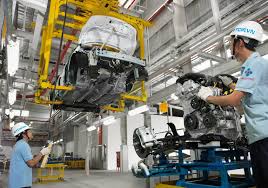Automobile industry seeks development path
VGP – The average income per capita of Vietnamese people was projected at US$ 3,000 by 2020, expected to lead to a boom in automobile demand. However, after years of development, the Vietnamese automobile industry has yet made breakthroughs and the prices of domestically assembled cars are still higher than imported ones.
Illustration photo
Abundant potentials but modest growth

The Department of Industry under the Ministry of Industry and Trade reported that by late 2016, Viet Nam houses 173 automobile production and assembling enterprises which together churn out a total output of about 500,000 cars per year. The FDI sector made up 47% of the market share and domestic enterprises accounted for 53%.
So far, big brands like Toyota, Huyndai, Kia, Mazda, Honda, GM, Chevrolet, Ford, Mitsubishi, Nissan, Suzuki, Isuzu, Mercedes-Benz, Hino have set foot in Viet Nam, meeting about 70% of domestic demands for less than nine-seat cars. Some domestic enterprises succeeded in partaking in the global automobile production chair.
Mr. Pham Tuan Anh, Deputy Director of the Industrial Department reported that under 7-ton vans and 25-seat passenger cars were localized, basically meeting d
Specifically, 7-ton vans met about 70% of demand with over 20% of localization rate. Over 10-seat passenger cars satisfied around 90% of demand with 45-55% of localization rate, exceeding the preset goal.
However, the domestic automobile production and assembly industry has yet met all criteria to become an actual sector and matured with simple production lines.
In addition, enterprises has yet forged cooperation, association, and profession among assembly, and spare part production.
So far, in Viet Nam, automobile costs are nearly double that of other regional countries such as Thailand and Indonesia.
In addition, the localization rate in Viet Nam was 65-70%, much lower than that of Thailand (with 80%).
Deputy Director Tuan Anh shared that without effective measures to raise the localization rate, it will be difficult for Viet Nam to compete with regional peers especially when Viet Nam joins AFTA.
Experts attributed small-sized market and low output to higher production costs in Viet Nam.
Eight synchronous solutions
The Deputy Director proposed a group of eight synchronous solutions to promote the domestic automobile industry.
Firstly, it is necessary to build an adequate market for the domestic automobile industry by applying measures to develop transparency via technical barriers and prevention of trade frauds.
Secondly, providing target support; raising production competence and business competitiveness for domestic automobile production and assembling enterprises; developing major products which are able to compete with regional ones.
Thirdly, adjusting import tariffs of spare parts;
Fourthly, applying special consumption tax in favour of domestically high added-value products;
Fifthly, early issuing a decree on conditions in production, assembling, import, business, service, and maintenance to regulate specific conditions in professions, assembling, automobile imports, service and business conditions;
Sixthly, researching and applying measures on trade defence in response to unexpectedly rising automobile imports, leading to remarkable impacts on domestic production in line with international commitments;
Seventhly, developing the auxiliary industries to raise localization rate of the domestic automobile industry;
Eighthly, researching and encouraging enterprises to invest in large-scale tramcar projects in Viet Nam for domestic demand and export./.
By Kim Loan

